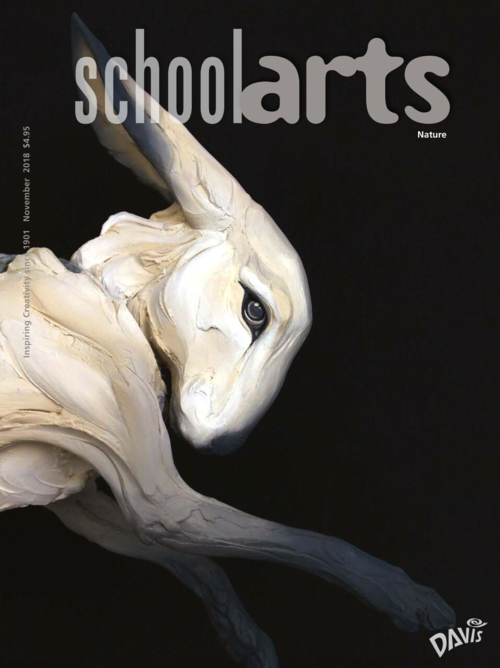 Caitlin Fitzmaurice, treescape painting, grade three.
Caitlin Fitzmaurice, treescape painting, grade three.
When drawing a tree, I encourage students to start at the base of the trunk and follow the contour line up the trunk, draw out a branch to the twigs at the end, and then go back to another branch and follow it. One branch at a time, the trees grow on students’ papers. We look for L, U, and V shapes where the branches fork from the trunk and each other.
Starting with the Sky
I began by instructing students to paint a band of any color across roughly the top quarter of a sheet of 18 x 24" (46 x 61 cm) paper. I demonstrated mixing paint colors directly on watery paper, but the painting method could be wet-on-wet, brush dabs, solid paint, or blended colors— anything but splattering would be okay. I purposely did not describe the project as a landscape painting because I wanted students’ color choice for the sky to be free from the restraints of “the sky is blue.”
Looking at Landscape Paintings
Once that first area was completed, I showed students a number of landscape paintings. I suggested they imagine walking into each painting, starting in the foreground, moving through to the middle ground, hiking all the way to the mountains in the background, and then looking up at the sky to check out the weather and time of day.
Painting the Background
By this time, students had figured out that the painting they started was going to become a landscape and those colorful areas they painted were the sky. We looked at the mountain areas in several paintings to note the more muted colors before students painted a second area below the skies in their paintings. For this section, I suggested experimenting with horizontal brushstrokes and blending several colors together directly on the paper.
Painting the Middle Ground
The third section became the forest in the middle ground; stippling with brush dabs was one option for the painting method. We discussed what season students wanted to create in their paintings and how they could do that by their choice of colors. Finally, the foreground appeared as a meadow or grassy area and the paintings were set aside to dry.
Branching Out into the Foreground
After we spent several classes outdoors drawing the shaggy bark of a river birch tree, a multi-branched apple tree, and the large trunk of an ancient silver maple, I brought out students’ paintings again and talked about how they might add a forest.
I reviewed a collection of our print-making tools and demonstrated several techniques, such as using thick sponges for tree trunks and thin sponge edges or cardboard pieces for tree branches. I also put out white paint and demonstrated techniques for dragging black paint from the shadow edge of the white trunk to create the look of a birch tree as well as shadows on the other trees.
Students were very enthusiastic as they added the forest to their paintings. The entire school enjoyed looking at the paintings on display in the hallways and on my Art News page on our school website.
Barbara Downing Owen is an art teacher at Tenacre Country Day School in Wellesley, Massachusetts. barbara_owen@tenacrecds.org
NATIONAL STANDARD
Connecting: Relating artistic ideas and work with personal meaning and external context.
WEB LINK
Tenacre Country Day School Student Art Gallery
View this article in the digital edition.


 Caitlin Fitzmaurice, treescape painting, grade three.
Caitlin Fitzmaurice, treescape painting, grade three.